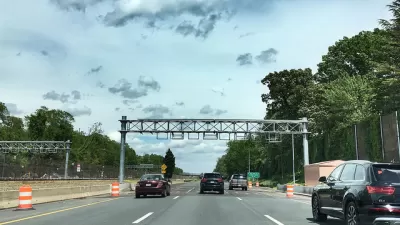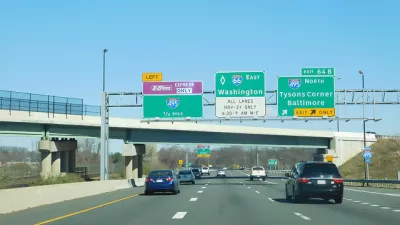The peak tolls achieved during the first week of operation of the new HOT lanes on I-66 in Virginia raised eyebrows this week. Here's a closer look at the data behind the new system.
Mike Grinnell takes a deep dive into the data behind the I-66 express lane system that went into operation this week, making headlines for charging $40 to access the new HOT lanes during the Tuesday morning peak period.
First, Grinnell makes clear the changes this week on I-66:
A few things changed for drivers with the introduction of these new HOT lanes, but the biggest change was for single-occupancy vehicle drivers. Previously they were restricted from driving on I-66 eastbound between 6:30 am and 9:00 am and westbound between 4:00 pm and 6:30 pm. Outside of these time restrictions, they were free to access the roads anytime.
Then, Grinnell compares the actual toll prices to the estimates prepared by the Virginia Department of Transportation two years ago when planning the HOT lane system. Despite the eye-popping figures picked up by news outlets around the country (including us), the numbers did hold pretty close to the original estimates.
By taking a closer look at the numbers, Grinnell is also able to pull a couple early lessons from the system, including when driving is most expensive and insight into how dynamic pricing works. Grinnell also reminds readers that the tolls will pay for the installation and upkeep of the tolling system in addition to multi-modal transportation improvements like bus service, park-n-ride facilities, improvements to Metro, and road improvements.
FULL STORY: After the outcry over the $40 tolls on I-66, this solo driver crunched the numbers

Planetizen Federal Action Tracker
A weekly monitor of how Trump’s orders and actions are impacting planners and planning in America.

Chicago’s Ghost Rails
Just beneath the surface of the modern city lie the remnants of its expansive early 20th-century streetcar system.

San Antonio and Austin are Fusing Into one Massive Megaregion
The region spanning the two central Texas cities is growing fast, posing challenges for local infrastructure and water supplies.

Since Zion's Shuttles Went Electric “The Smog is Gone”
Visitors to Zion National Park can enjoy the canyon via the nation’s first fully electric park shuttle system.

Trump Distributing DOT Safety Funds at 1/10 Rate of Biden
Funds for Safe Streets and other transportation safety and equity programs are being held up by administrative reviews and conflicts with the Trump administration’s priorities.

German Cities Subsidize Taxis for Women Amid Wave of Violence
Free or low-cost taxi rides can help women navigate cities more safely, but critics say the programs don't address the root causes of violence against women.
Urban Design for Planners 1: Software Tools
This six-course series explores essential urban design concepts using open source software and equips planners with the tools they need to participate fully in the urban design process.
Planning for Universal Design
Learn the tools for implementing Universal Design in planning regulations.
planning NEXT
Appalachian Highlands Housing Partners
Mpact (founded as Rail~Volution)
City of Camden Redevelopment Agency
City of Astoria
City of Portland
City of Laramie




























